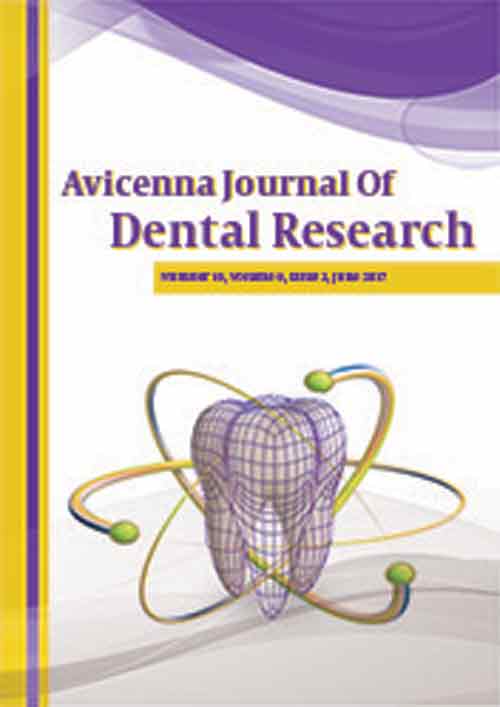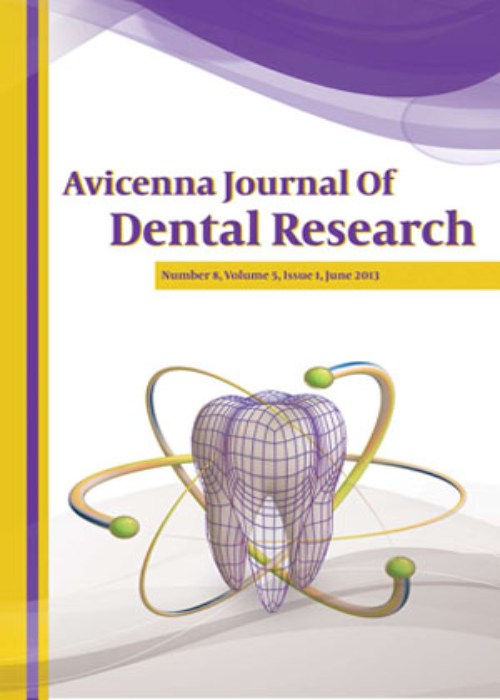فهرست مطالب

Avicenna Journal of Dental Research
Volume:9 Issue: 3, Sep 2017
- تاریخ انتشار: 1396/07/11
- تعداد عناوین: 8
-
-
Page 1ObjectivesSince earlier studies on the association between dental caries with birth problems are very controversial, this study assessed the potential association between DMFT index with low birth and preterm birth.MethodsIn this matched case-control study, 150 children were divided into 75 case (premature birth and low birth weight) and 75 control subjects. The 2 groups were balanced according to age, gender, socioeconomic statuses (including mothers and fathers education, family size, district of residence, and type of the kindergarten), mothers job (yes/no), common types of diets during the first 2 years of life, brushing, dental visits, being right-handed or left-handed, and fluoride therapy. The DMFT of children were assessed by a dental student. Their gestational age at birth and birth weight were asked from their parents. The effects of the factors premature birth (less than 37 weeks) and low birth weight (less than 2500 gm) on DMFT were assessed using Chi-square test (α = 0.05).ResultsThe 2 groups did not have any significant differences regarding the balanced characteristics. We did not detect a statistically significant result between case children with DMFT > 2 and low-birth weight (P = 0.065) defined as weights ≤ 2500 gm or > 2500 gm (P = 0.174). This study also failed to find a significant result regarding gestational age and DMFT (P = 0.480).ConclusionsThis study did not detect significant associations between low birth weight or preterm birth and DMFT values in primary dentition.Keywords: Low Birth Weight, Preterm Birth (Premature Birth), Dental Caries, dmft
-
Page 2Background And ObjectivesPrevious studies have shown that increasing collagen resistance to degradation stabilizes the resin-dentin interface and collagen cross-linkers can prevent the degradation of collagen fibrils as such. This study sought to assess the efficacy of light-activated riboflavin for collagen cross-linking and optimizing the micro tensile bond strength (µTBS) of an etch and rinse adhesive system to dentin.MethodsOcclusal surfaces of 12 sound premolars were ground in order to expose dentin. The teeth were randomly divided into two groups. Adper single bond was applied on etched dentin and light cured in the control group and Composite was then applied. In the test group, all the steps were done in a similar manner to the control group with the difference that after acid etching, 0.1% riboflavin solution was applied on dentin surface and was activated by blue light irradiation for 2 minutes. After thermocycling, the teeth were sectioned in 2 directions in such a way that 14 resin-dentin sticks with 1 mm2 cross-section were prepared in each group (n = 14). The µTBS of samples was then measured and analyzed with independent t-test. The statistical analyses significance level was set at α = 0.05. Mode of failure was determined under a stereomicroscope at × 40 magnification. Moreover, the cross-linking effect of light-activated riboflavin solution on type I collagen was assessed using sodium dodecyl sulfate-polyacrylamide gel electrophoresis (SDS-PAGE) and resin-dentin interface was photographed under a scanning electron microscope (SEM).ResultsIn gel electrophoresis, bands were formed in wells in the test group (and not in the negative control group). T-test found no significant difference in the mean µTBS of the test and the control groups (P = 0.9).ConclusionsBased on the results, light-activated riboflavin was capable of collagen cross-linking, but its application as a collagen cross-linker on etched dentin had no significant effect on µTBS of Single Bond dentin bonding agent to dentin.Keywords: Photo, Activation, Riboflavin, Crosslinking, Dentin, Biodegradation, Collagen
-
Page 3BackgroundZygomatic fractures are among the most common maxillofacial injuries.ObjectivesThis study aimed to assess the incidence and causes of zygomatic fractures in patients referring to Tehran Taleghani hospital during a 10-year period.MethodsThis descriptive, retrospective, cross-sectional study was conducted on 294 records of patients (248 males and 46 females) with zygomatic fractures selected via census in Tehran Taleghani hospital from 2003 to 2013. Age, gender, cause of fracture, type of treatment modality, and post-operative complications were extracted and reported by using descriptive statistics. Data were analyzed using chi square and Fishers exact tests.ResultsMost patients were aged 20 - 30 years (n = 121, 42.1%). Car accident (n = 97, 33%), motorcycle accident (n = 89, 30.3%), and fall from height (n = 44, 15.1%) were the most common causes of fractures. The most common associated fracture was mandibular fracture (n = 104, 35.4%). The most common type of zygomatic fracture was zygomaticomaxillary complex (ZMC) fractures (87.3%) treated by open reduction with internal fixation (84.8%). Paresthesia or hypoesthesia of the infraorbital nerve (n = 177, 64.6%) was the most common complication. Periorbital ecchymosis (n = 159, 58%) was the most common ocular complication. Epistaxis (P = 0.01), paresthesia and hypoesthesia of infraorbital nerve (P = 0.016), enophthalmos (P = 0.014), step formation at the inferior orbital rim (PConclusionsZygomatic fractures comprised 22.8% of all maxillofacial injuries and they occurred mainly due to traffic accidents with a higher prevalence in males aged 20 - 30 years. They were mostly treated by open reduction with internal fixation.Keywords: Zygomatic Fractures, Maxillofacial Injuries, Prevalence
-
Page 4BackgroundBlood contamination could interfere with the bonding of resin materials to different substrates.ObjectivesThe purpose of this study was to evaluate the effects of various methods of removing blood contamination between composite resin increments on resin-resin micro-shear bond strength.Methods90 composite blocks (Valux Plus, 3M ESPE) measuring 2 × 2 × 8 mm were prepared in 6 groups: one group was not contaminated as the control (group 1); for other groups the surface was contaminated with blood then rinsed and dried. One group only received this treatment (group 2) and others were etched with phosphoric acid (group 3), phosphoric acid and a bonding agent (Margin Bond, Coltene) (group 4), cleaned with 98% ethanol (group 5), and had 0.5 mm of their outer surface removed (group 6). Next, the second increments of composite were applied in the form of cylinders of 0.7 mm diameter and 1 mm height on the top surfaces of the specimens and were then light cured. Specimens underwent micro-shear bond strength testing. Data were analyzed by Kolmogorov-Smirnov and analysis of variance (ANOVA) tests.ResultsThe mean value of bond strength was 23 ± 3.60 MPa for the control group, 17.89 ± 6.52 MPa for group 2, 19.40 ± 6.08 MPa for group 3, 20.20 ± 5.72 MPa for group 4, 20.01 ± 6.83 MPa for group 5, and 19.10 ± 6.20 MPa for group 6. There were no significant differences between the groups.ConclusionsAll the decontamination methods in this study could increase the resin-resin bond strength to the level of the control group.Keywords: Blood Contamination, Decontamination Method, Resin, Resin Micro, Shear Bond Strength
-
Page 5BackgroundZinc oxide (ZnO) that is a main component of Zinc Polycarboxylate and Zinc Phosphate conventional cements has been incorporated into many dental materials for mechanical enhancement. Moreover, by decreasing the particle size of ZnO down to nano-scale, its beneficial effects would tremendously increase because the nanoparticles have considerably higher surface to volume ratio compared to micro-particles.ObjectivesThe aim of this study was to assess mechanical, physical, and chemical properties of Zinc Polycarboxylate and Zinc Phosphate cements containing Zinc oxide nanoparticles.MethodsThree powder formulations were prepared for either of the cements based on the nanoparticles content (0 wt%, 10 wt% before, and 10 wt% after sintering the powder). The prepared groups were compared with each other in terms of their compressive strength, setting time, film thickness, and acid erosion resistance using one way ANOVA and Tukey HSD statistical tests (α = 0.05).ResultsIncorporating zinc oxide nanoparticles did not significantly change neither the film thickness nor the acid erosion resistance of the cements (P > 0.05). Nevertheless, the setting time of zinc phosphate significantly decreased by adding nanoparticles (P 0.05). On the other hand, although incorporating nanoparticles significantly reduced the compressive strength of zinc phosphate (PConclusionsBy incorporating 10 wt% of nano zinc oxide into zinc phosphate and zinc polycarboxylate cements, their compressive strength are more affected rather than their setting time, film thickness, and acid erosion resistance.Keywords: Nanoparticles, Zinc Oxide, Dental Cement, Film Thickness, Setting Time, Acid Erosion, Compressive Strength
-
Page 6BackgroundCalcification and morphological variation are fairly common in patients presenting to oral and maxillofacial radiology clinics with stylohyoid complex.ObjectivesThe present study used digital radiography to investigate in detail whether or not elongated stylohyoid complex is linked to clinical symptoms, gender, and increased age. Finding such relationship can affect the diagnosis of the condition and the selection of treatments.MethodsThe present cross-sectional study was conducted on 186 patients aged 30 to 70 presenting to a private oral and maxillofacial radiology clinic in Rafsanjan, Iran, for digital dental panoramic radiography. All the patients completed a demographic questionnaire and clinical symptoms associated with stylohyoid complex. The chi-square test and Fishers exact test were used to compare categorical variables, while independent two-sample t-test and one-way ANOVA were used to compare quantitative variables, in both men and women and across age groups. The significance level was set at 0.05.ResultsA total of 186 participants entered the study, consisting of 90 men (48.4%) and 96 women (51.6%). The mean stylohyoid process size was calculated as 27.08 ± 7.80. The most common radiographic morphology (on both the right and the left sides) was continuous, followed by pseudo calcified and segmental. The most common calcification pattern observed on both sides was completely calcified pattern, followed by partially calcified pattern, calcified outline, and nodular pattern.ConclusionsAccording to the results obtained, the calcification and elongation of the stylohyoid process as shown by radiography are more of a physiological than pathological phenomenon that exacerbates with age.Keywords: Styloid, Stylohyoid Syndrome, Elongated Styloid Process Syndrome, Panoramic Radiography
-
Page 7IntroductionA new piezoelectric surgical device, a new system for cutting bone system, has recently been developed. It uses low-frequency ultrasonic vibrations to shape and cut bone.Case PresentationIn this paper, we report the case of a 70-year-old woman affected by (G2, T1, M0) oral cancer treated with osteotomy performed using this piezoelectric device. The case presents the complete surgical excision of a fornix squamous cell carcinoma in which the marginal mandibulectomy was effected by a piezoelectric system.ConclusionsPeople who have conditions involving bone that need to be surgically removed specifically nearby soft tissues or important structures (vessels, nerves, or brain), may benefit from this device. In the oral cavity, where the presence of essential structures may hinder safe osteotomy, the piezoelectric device allows the surgeon to cut bone without damaging nerves, glands, and vessels, even when in contact with them. The presence of angled inserts is also fundamental and facilitates osteotomies in areas that are unreachable by conventional cutters and burs.Keywords: Piezoelectric Device, Oral Cancer, Oral Surgery, Head, Neck Surgery
-
Page 8IntroductionSmall cell neuroendocrine carcinomas (SmCCs) of the salivary glands are rare high grade malignant neoplasms, and the identification of these lesions is often difficult. Histopathological features alone are not sufficient for the diagnosis of SmCCs, and immunohistochemical (IHC) staining is almost always mandatory for confirming the diagnosis.Case PresentationWe report one salivary SmCC case in a female who presented with swelling on the left side of the face. For a distinct diagnosis, histopathological and IHC evaluation was performed.ConclusionsThe presentation of these cases can be helpful for the histopathological differential diagnosis of similar tumorsKeywords: Case Report, Small Cell Carcinoma, Neuroendocrine, Salivary Glands


